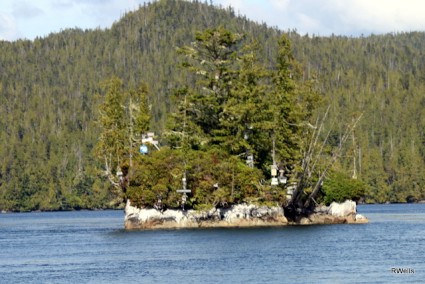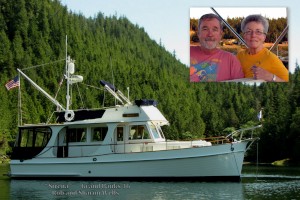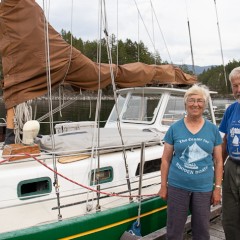
Travels on the Inside Passage
A log of cruising adventures in coastal areas of British Columbia, Canada and in Southeast Alaska.
07 September 2014 | Ganges, B.C.
05 September 2014 | Quadra Island, B.C
25 August 2014 | Posted at Kwatsi Bay
19 August 2014 | Posted at Kwatsi Bay
15 August 2014 | Posted at Kwatsi Bay
15 August 2014 | Posted at Kwatsi Bay
14 August 2014 | Posted in Port McNeill
14 August 2014 | Posted in Port McNeill
14 August 2014 | Posted in Port McNeill
28 July 2014 | Posted in Port McNeill
26 July 2014 | Posted in Port McNeill
25 July 2014 | Posted in Port McNeill
22 July 2014 | Jennis Bay, Drury Inlet
Moving on to Nakwakto Rapids
14 August 2014 | Posted in Port McNeill
Dense Fog

Thursday, 07 August 2014
We are replenished and ready so we depart at 0600 to get across Queen Charlotte Strait before the winds pick up in the afternoon. Our anchorage today will be in Skull Cove on Bramham Island at the mouth of Schooner Channel. This will be our staging point to transit the Nakwakto Rapids on Friday. Skull Cove is empty when we arrive at 1230 after a foggy passage across the strait. We anchor and the fog lifts. We spend the afternoon watching the sea birds that populate the cove. As evening falls, another boat finds her way in through the re-forming fog and anchors astern of us for the night.
Our plan is to spend some time exploring the waters inland from the rapids: Seymour and Belize Inlets. The gateway to these inlets, Nakwakto Rapids, are considered one of the world's fastest moving bodies of salt water. They can reach speeds of up to 14 knots on maximum ebb tides. Our guide books give detailed descriptions of how to run these rapids, at slack current, and we plan to follow their advice precisely. We have used the tide and current tables to calculate high slack to be at 1500 (3 p.m.) on Friday.
Friday, 08 August 2014
The fog persists in Skull Cove until after lunch and clears in time for us to start moving towards the rapids. We have the flooding current pushing us up Schooner Channel and arrive a bit early. Cougar Inlet is the last quiet water refuge outside the rapids and we spend a half hour inside the entrance. Our transit of the Nakwaktos is easy, we go through at 1445 with the aid of the dying flood. There is a small islet in the middle of the narrows that divides the rapids in two. We transit east of the islet, Turret Rock is the official name on the chart. Locally the islet is referred to as Tremble Island – it is said the current here flows with such ferocity that the rock shakes perceptibly in large tide. We decide to not test the lore, at least on this trip. There are wood signs nailed to the trees with the names of other vessels that have braved the Nakwakto Rapids.
We travel up Belize Inlet and find anchorage in Westerman Bay. We have not seen any other cruising boats today and have the anchorage to ourselves. This will turn out to be a recurring theme as very few cruisers visit this area.
We are replenished and ready so we depart at 0600 to get across Queen Charlotte Strait before the winds pick up in the afternoon. Our anchorage today will be in Skull Cove on Bramham Island at the mouth of Schooner Channel. This will be our staging point to transit the Nakwakto Rapids on Friday. Skull Cove is empty when we arrive at 1230 after a foggy passage across the strait. We anchor and the fog lifts. We spend the afternoon watching the sea birds that populate the cove. As evening falls, another boat finds her way in through the re-forming fog and anchors astern of us for the night.
Our plan is to spend some time exploring the waters inland from the rapids: Seymour and Belize Inlets. The gateway to these inlets, Nakwakto Rapids, are considered one of the world's fastest moving bodies of salt water. They can reach speeds of up to 14 knots on maximum ebb tides. Our guide books give detailed descriptions of how to run these rapids, at slack current, and we plan to follow their advice precisely. We have used the tide and current tables to calculate high slack to be at 1500 (3 p.m.) on Friday.
Friday, 08 August 2014
The fog persists in Skull Cove until after lunch and clears in time for us to start moving towards the rapids. We have the flooding current pushing us up Schooner Channel and arrive a bit early. Cougar Inlet is the last quiet water refuge outside the rapids and we spend a half hour inside the entrance. Our transit of the Nakwaktos is easy, we go through at 1445 with the aid of the dying flood. There is a small islet in the middle of the narrows that divides the rapids in two. We transit east of the islet, Turret Rock is the official name on the chart. Locally the islet is referred to as Tremble Island – it is said the current here flows with such ferocity that the rock shakes perceptibly in large tide. We decide to not test the lore, at least on this trip. There are wood signs nailed to the trees with the names of other vessels that have braved the Nakwakto Rapids.
We travel up Belize Inlet and find anchorage in Westerman Bay. We have not seen any other cruising boats today and have the anchorage to ourselves. This will turn out to be a recurring theme as very few cruisers visit this area.
Comments
| Vessel Name: | Sirena |
| Vessel Make/Model: | Grand Banks 36 Europa |
| Hailing Port: | Bellingham WA |
| Crew: | Rob and Sharon |
| About: | We are retired and cruise the waters of the Pacific Northwest. |
| Extra: | "Sirena" is a 1989 Grand Banks trawler. She has a single engine and all the amenities to make life on board comfortable. |
Gallery not available
M/Y SIRENA

Who: Rob and Sharon
Port: Bellingham WA

